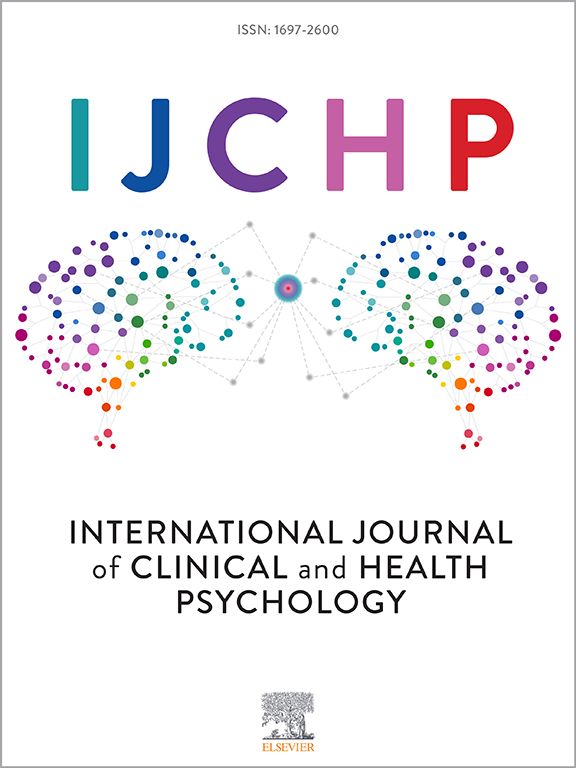The effects of transcranial magnetic stimulation on cognitive flexibility among undergraduates with insomnia symptoms: A prospective, single-blind, randomized control trial
IF 4.4
1区 心理学
Q1 PSYCHOLOGY, CLINICAL
International Journal of Clinical and Health Psychology
Pub Date : 2025-04-01
DOI:10.1016/j.ijchp.2025.100567
引用次数: 0
Abstract
Backgrounds
Repetitive transcranial magnetic stimulation(rTMS) has been widely used in the treatment of insomnia, but there is a lack of research on whether this method could enhance the cognitive flexibility(CF) of individuals with insomnia symptoms.
Objectives
To investigate the effects of rTMS on the CF of undergraduates with insomnia symptoms.
Methods
29 participants were randomly assigned into Active group(n = 15) and Sham group(n = 14), receiving 1 Hz rTMS interventions targeting the left dorsolateral prefrontal cortex for 2 weeks, comprising 10 sessions (active vs sham stimulation). Sleep quality and CF were assessed using the Pittsburgh Sleep Quality Index(PSQI), Insomnia Severity Index(ISI), Cognitive Flexibility Inventory(CFI), and the Number-Letter Task (N-L task) at baseline(T0), post-intervention(T1), and 8 weeks’ follow-up(T2), and event-related potential(ERP) data during the N-L task were recorded.
Results
Following the intervention, compared to the Sham group, the ISI and PSQI scores in the Active group were significantly decreased, and the CFI score was significantly increased (P < 0.01); the results of the N-L task indicated that at T1, the switch cost of reaction time and accuracy for the Sham group were significantly higher than those for the Active group(P < 0.05). ERP analysis indicated that at T2, under switch conditions, the amplitude of the frontal area P2 in the Active group was significantly greater than that in the Sham group, and the beta-band ERD at parietal region in the Active group was significantly lower than that in the Sham group (P < 0.05).
Conclusions
rTMS could improve sleep quality and enhance the CF of undergraduates with insomnia symptoms.
Clinical Trials Registration
The effect of transcranial magnetic stimulation on cognitive flexibility in college students with insomnia (ChiCTR2400081263) URL: https://www.chictr.org.cn/showproj.html?proj=202951
经颅磁刺激对有失眠症状的大学生认知灵活性的影响:一项前瞻性、单盲、随机对照试验
背景重复经颅磁刺激(rTMS)已被广泛应用于失眠的治疗,但该方法是否能提高失眠患者的认知灵活性(CF),目前还缺乏研究。目的探讨rTMS对有失眠症状的大学生CF的影响。方法29名参与者随机分为活跃组(n = 15)和假手术组(n = 14),接受针对左背外侧前额叶皮层的1 Hz rTMS干预,为期2周,包括10个疗程(活跃和假手术刺激)。采用匹兹堡睡眠质量指数(PSQI)、失眠严重程度指数(ISI)、认知灵活性量表(CFI)和基线(T0)、干预后(T1)和8周随访(T2)时的数字-字母任务(N-L任务)评估睡眠质量和CF,并记录N-L任务期间的事件相关电位(ERP)数据。结果干预后,与Sham组比较,Active组ISI、PSQI评分显著降低,CFI评分显著升高(P <;0.01);N-L任务结果显示,在T1时,假手术组的反应时间转换成本和准确性显著高于手术组(P <;0.05)。ERP分析显示,在T2时,开关条件下,Active组脑额区P2振幅显著大于Sham组,顶叶区β带ERD显著低于Sham组(P <;0.05)。结论srtms可改善大学生失眠症状患者的睡眠质量,增强CF。经颅磁刺激对大学生失眠症患者认知灵活性的影响(ChiCTR2400081263) URL: https://www.chictr.org.cn/showproj.html?proj=202951
本文章由计算机程序翻译,如有差异,请以英文原文为准。
求助全文
约1分钟内获得全文
求助全文
来源期刊

International Journal of Clinical and Health Psychology
PSYCHOLOGY, CLINICAL-
CiteScore
10.70
自引率
5.70%
发文量
38
审稿时长
33 days
期刊介绍:
The International Journal of Clinical and Health Psychology is dedicated to publishing manuscripts with a strong emphasis on both basic and applied research, encompassing experimental, clinical, and theoretical contributions that advance the fields of Clinical and Health Psychology. With a focus on four core domains—clinical psychology and psychotherapy, psychopathology, health psychology, and clinical neurosciences—the IJCHP seeks to provide a comprehensive platform for scholarly discourse and innovation. The journal accepts Original Articles (empirical studies) and Review Articles. Manuscripts submitted to IJCHP should be original and not previously published or under consideration elsewhere. All signing authors must unanimously agree on the submitted version of the manuscript. By submitting their work, authors agree to transfer their copyrights to the Journal for the duration of the editorial process.
 求助内容:
求助内容: 应助结果提醒方式:
应助结果提醒方式:


